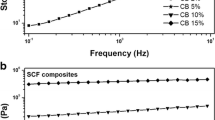Abstract
Thin polyvinylidene fluoride-silicon carbide (PVDF-SiC) shielding composite films were prepared by a simple solution casting process. X-ray diffraction (XRD) and scanning electron microscopy (SEM) show the presence of both polymer and filler with no reaction between them. The coefficient of thermal expansion (CTE) and tensile strength of the composite exhibit a decreasing tendency, while that of conductivity and electromagnetic interference (EMI) shielding values increase with filler loading. The εr, and tanδ of the composites were also found to increase with filler loading in the frequency range of 8.2–18 GHz, which also influence the shielding behaviour of the composite. The high filler (60 vol.% of SiC) loaded composite of 1 mm thickness exhibits direct current (DC) conductivity of the order of 10−5 S/m indicating its potential for electrostatic discharge shielding applications. This is further confirmed from its EMI SE value of 12 dB, which corresponds 94% attenuation. The composite exhibits a partially reflecting and absorbing shielding nature, without any dominant shielding mechanism. The alternating current (AC) conductivity and skin depth value of the composites exhibit an inverse relationship with each other and influence the shielding thickness. The attenuating power of the PVDF-SiC composite with 60 volume % (vol.%) silicon carbide (SiC) changes from 84% to 99%, with an increase in sample thickness from 0.5 mm to 2 mm. Hence, thin and flexible paper-like EMI shield of PVDF-SiC composite can be easily prepared by simple, cost-effective approach for various shielding applications like electrostatic discharge shielding as well as EMI shielding.
Similar content being viewed by others
References
Y. Li, H. Yang, X. Hao, N. Sun, J. Du, and M. Cao, J. Alloys Compd. 772, 99 (2019).
Y. Mamunyaa, L. Matzuib, L. Vovchenkob, O. Maruzhenkoa, V. Oliynykb, S. Puszc, B. Kumanekc, and U. Szelugac, Compos. Sci. Technol. 170, 51 (2019).
S. Iqbal, J. Shah, R.K. Kotnala, and S. Ahmad, J. Alloys Compd. 779, 487 (2019).
S. Lin, S. Ju, J. Zhang, G. Shi, Y. He, and D. Jiang, RSC Adv. 9, 1419 (2019).
N. Bagotiaa, V. Choudharyb, and D.K. Sharma, Compos. B 159, 378 (2019).
R. Ramasubramaniam, J. Chen, and H. Liu, Appl. Phys. Lett. 83, 2928 (2003).
W.D. Kimmel and D.D. Gerke, Med. Dev. Diagn. Ind. 20, 102 (1998).
J.E. Vinson and J.J. Liou, Proc. IEEE 86, 399 (1998).
N. Joseph, J. Chameswary, and M.T. Sebastian, Compos. Sci. Technol. 101, 139 (2014).
Z. An, C. Ye, R. Zhang, and Q. Qu, J. Sol-Gel. Sci. Technol. 89, 623 (2019).
M. Izawa, T. Koseki, Y. Kamiya, and T. Toyomasu, Rev. Sci. Instrum. 66, 1910 (1995).
C. Wang, Y. Liu, Q. You, F. Ye, and L. Cheng, Ceram. Int. 45, 5637 (2019).
L.Q. Chen, X.W. Yin, X.M. Fan, M. Chen, X.K. Ma, L.F. Cheng, and L.T. Zhang, Carbon 95, 10 (2015).
H. Wang, D. Zhu, Y. Mu, W. Zhou, and F. Luo, Ceram. Int. 41, 14094 (2015).
D.H. Ding, Y.M. Shi, Z.H. Wu, W.C. Zhou, F. Luo, and J. Chen, Carbon 60, 552 (2013).
H. Mei, D.Y. Han, S.S. Xiao, T.M. Ji, J. Tang, and L.F. Cheng, Carbon 109, 149 (2016).
N. Joseph and M.T. Sebastian, Mater. Lett. 90, 64 (2013).
N. Joseph, J. Varghese, and M.T. Sebastian, Compos. B 123, 271 (2017).
N. Joseph, S.K. Singh, R.K. Sirugudu, V.R.K. Murthy, S. Ananthakumar, and M.T. Sebastian, Mater. Res. Bull. 48, 1681 (2013).
R.K. Goyal, A.N. Tiwari, U.P. Mulik, and Y.S. Negi, Compos. Sci. Technol. 67, 1802 (2007).
M. Rusu, N. Sofian, and D. Rusu, Polym. Test. 20, 409 (2001).
K.P. Murali, S. Rajesh, O. Prakash, A.R. Kulkarni, and R. Ratheesh, Compos. Part A 40, 1179 (2009).
M.T. Sebastian, Dielectrics for Wireless Communications (UK: Elsevier, 2008).
J. Sun, J. Li, G. Sun, B. Zhang, S. Zhang, and H. Zhai, Ceram. Int. 28, 741 (2002).
N. Joseph, J. Varghese, and M.T. Sebastian, J. Mater. Chem. C 4, 999 (2016).
N. Joseph, J. Varghese, and M.T. Sebastian, Polym. J. 49, 391 (2017).
N. Joseph, J. Varghese, and M.T. Sebastian, RSC Adv. 5, 20459 (2015).
Author information
Authors and Affiliations
Corresponding author
Additional information
Publisher's Note
Springer Nature remains neutral with regard to jurisdictional claims in published maps and institutional affiliations.
Rights and permissions
About this article
Cite this article
Joseph, N., Varghese, J. & Sebastian, M.T. PVDF-SIC Composite Thick Films an Effective ESD Composition for Growing Anti-static Applications. J. Electron. Mater. 49, 1638–1645 (2020). https://doi.org/10.1007/s11664-019-07538-3
Received:
Accepted:
Published:
Issue Date:
DOI: https://doi.org/10.1007/s11664-019-07538-3




